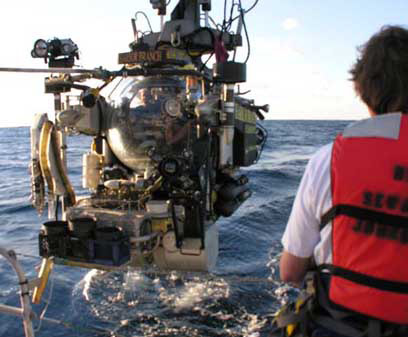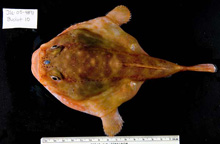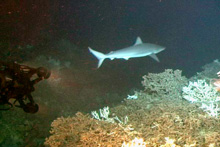
Deployment of the Johnson Sea-Link submersible for the first dive of Life on the Edge 2005. Click image for larger view and image credit.
One Good Dive Deserves Another
October 17, 2005
Bob Schwartz
Web Coordinator
NOAA Public Affairs
Today, the first full day of the expedition, went extremely well. We conducted two very productive dives, brought back a lot of samples, and even encountered a large bignose shark during the morning dive.
Both dives were conducted at Lophelia coral banks off Cape Lookout, NC, at a site that the science team has visited every year since 2000. Dr. Steve Ross explained why he chose to visit this site again. "You don't get all the data you need in one cruise or one year. When you go once a year or so, it takes several years to build up an inventory of data where you feel like you're not adding new species every dive," he said. "When one of your objectives is to characterize community structure, you want to make sure you're seeing all the community. The first time you go anywhere, everything you see is new. The second time you go somewhere, a big percentage of things are new, but not as many. You construct what's called an accumulation curve. When that curve starts to level out, you feel like you've started to characterize the community," he explained. Dr. Ross explains that there's more to exploration than just finding new places and things nobody has ever seen before. "Many explorers only go to a new place once," he said. "We never go to a place once. We didn't go to the moon once; we learned new things every time. Our work requires a methodology that will build up a database. So it takes a while to do that. It takes repetition, consistency. Then you can publish something with some assurance. You can say you have a stack of data behind what you're trying to say; that it's led to this conclusion or these new questions or new hypotheses. But you'd be on much thinner ice with less data. That's been a huge advantage to us, coming out here 5 or 6 or 7 years and continuing to hit some of the same areas," he said.
According to Dr. Ross, such consistency is critical for work that has to do with animal and habitat associations. "Just because you see a crab or a fish on a piece of coral once does not mean you're seeing a common pattern. To determine patterns requires a lot of repetition because animals move around, habitats change. If we come out here and, every time, we see that animal doing the same thing on that coral, now we've got a story we can sell concerning animal and habitat relationships," he said.
"That feeds directly into the management community heading in the direction of [fishery] ecosystem management. That's a NOAA initiative, a Fisheries Council initiative, and part of that is considering the habitat and everything that's tied to it, even if it's not considered commercially important," he said.“For years and years, nobody funded research on anything but commercially important species. Now we’re saying, ‘gee, maybe we should study the things that they eat,’” he said.
Life on the Edge will be sending daily reports from Oct 16 - Nov 4. Please check back frequently for additional logs from this expedition.
Sign up for the Ocean Explorer E-mail Update List.



























